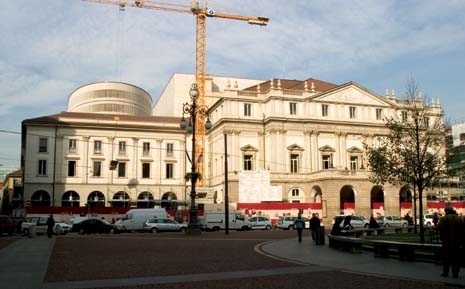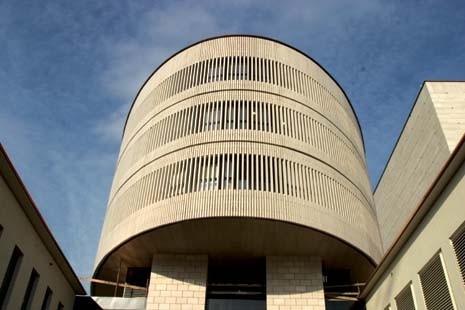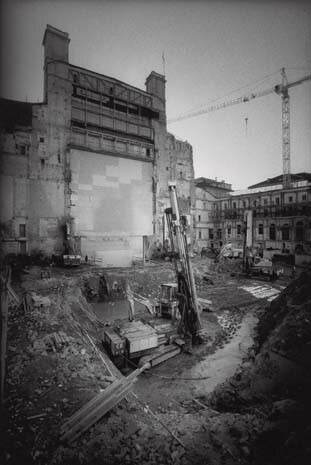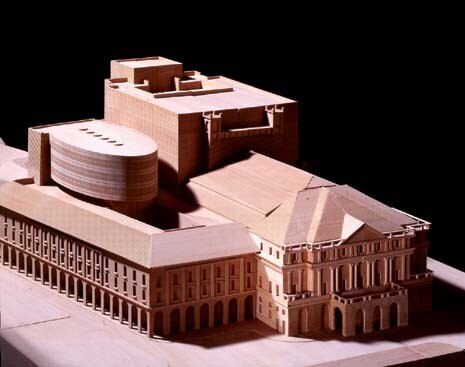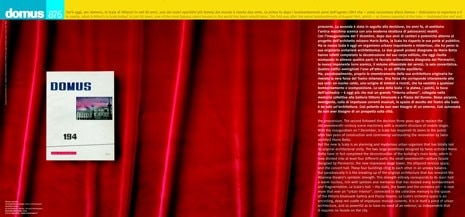“Look on my Works, ye Mighty, and despair!” (from: Percy Bysshe Shelley, Ozymandius, 1817)
Beyond the ruins
Just over a year ago, Domus published a wide-ranging investigation into the “conservative restoration” of La Scala, the world’s most celebrated opera house, as it re-opened after an expensive and controversial “restoration”. As the edition went to press, a debate was organised at Milan’s Triennale museum. The room was packed as architects, planners, politicians and journalists argued – furiously – over the new building. This was a rich debate: emotional, angry, passionate. It was also a debate which had come far too late. By the time we had all gathered at the Triennale, the “new” La Scala was already finished. There was no turning back. It is well-known that no competition had been held for the “restoration”. The Triennale debate was useless – it could have no effect on the reality of the city of Milan – the new La Scala was simply presented as a triumphant fait accompli, a marvellous example of the Milanese work-ethic which had defeated the “conservatives”. Domus was a voice in the wilderness, amidst the triumph of the opening night. The suspicion that the left had supported the whole project – thanks to the fact that the building firm were linked to the cooperatives – was confirmed at the 2005 Festa Nazionale dell’Unita, where visitors were treated to a rather sad “recreation” of La Scala, complete with green plastic grass on the way in.
The king has no clothes
The opening night On the 7th December 2004, in front of the eyes of the entire planet, the new La Scala opened its doors for the first time. It was a triumph. Milan seemed to have gone back to the glorious, happy-go-lucky days of the 1980s, when the stock exchange was booming and the Socialist Party reigned supreme. Tickets were going for 1,500 euros outside the opera house on the night. The stars also turned out. Sofia Loren was there, as were the Prime Ministers of Bulgaria, Croatia and Albania and the President of the Greek Federation, along with eight Italian ministers and Giorgio Armani. Silvio Berlusconi sat in the Royal Box, and commented that. “Bello, vero? It’s wonderful. Vero?” 15 minutes of applause followed the opera itself and a 1,000 strong gala dinner followed – appropriately – in the ex-Ansaldo factory which had hosted Bettino Craxi’s Party Congress in 1985, when the Socialist leader was at the height of his powers. Many of those present argued that the re-opening of La Scala signalled the “rebirth of Milan”. For the musical director Riccardo Muti it was “the joy of the orchestra, of the chorus, of the dancers, of the technicians and of the costume designers which was the clearest demonstration that the Scala family has rediscovered its house and has been happy to re-open with this opera.”
Disaster. Intrigue. Purges
The King, however, was without his clothes. Since the opening night, La Scala has lurched from crisis to crisis. “The Scala Family” has gone through a series of very public divorces. All those from within the organisation who presided over the expensive “restoration” have left, usually in controversial circumstances. In February Carlo Fontana, sovrintendente of the opera house, was “relieved of his post” seven months before the end of his contract. Fontana had been the most fervent supporter of the wholesale renewal of the building and had argued that such work was not only important but necessary for the survival of La Scala. On the 18th March the artistic director Muti resigned after twenty years at La Scala, after his orchestra refused to play under him, in an unprecedented form of musical revolution. He wrote an open letter to the “Dear Professors of the Orchestra...” arguing that in “the climate of rumor, insults and misunderstandings which had been created it was impossible to make music together any longer.” Huge debts were “discovered” (some reports spoke of at least 16 millions Euros). The two most important personalities to preside over the extremely expensive restoration had gone. In their place arrived a Frenchman – Stéphane Lissner – and an Italian – Mauro Meli.
Balance Sheet. The New La Scala
Mario Botta often describes the critics of the new La Scala as “conservatives”, laying out his contribution to the building as “radical”. Perhaps. Certainly, there are conservatives amongst those who opposed, and continue to criticise, the Bottaesque addition to La Scala’s roof. However, the main objection to Botta’s gleaming ellipse is not that it is “too radical,” but that it was constructed without recourse to an international competition, by diktat. Opening up the La Scala debate at an earlier stage would also have allowed for more radical proposals to be put forward. Unfortunately, such a decision was taken out of the hands of the Milanese, who were never given a chance to see the building until it was half-completed. Architecture by diktat – using public money – was thus the method imposed for La Scala. Far from exemplifying modernism and radicalism, the method behind the new building was a prime example of conservatism. Debate was stifled, information was repressed. The whole affair was reminiscent of the architectural practices of a Stalinist regime, not of a supposed democracy. The Milanese left – with the exception of the Greens – must also take responsibility for this situation. The celebratory – and sad – celebration of the new La Scala to be found at July’s Festa Nazionale dell’Unità, complete with green plastic carpets, only confirmed fears that many on the official left ‘kept quiet’ due to the key role of the ‘red’ cooperative in the building work. As for the restoration of the theatre itself, this was done with loving care and extreme attention to detail. It is only a pity that the extraordinary work of Elizabetta Fabbri has been nigh-on forgotten – and silenced – amidst the architectural and personalist protagonism of the Botta-Tower project. Even Silvio Berlusconi has turned against the theatre he praised in December 2004, arguing that the company has “too many” workers and ordering his culture minister to prepare a “dossier” into the management of the opera house.
The empty theatre. Arcimboldi
A few kilometres to the north of the city, in the new Bicocca neighbourhood, lies a huge theatre, with more seating space than La Scala itself. Built at a cost of 85 billion lire (55 billion came from Pirelli, 30 from the Comune di Milano) the theatre was first opened in January 2002. But this gleaming, impressive building has only run for two full seasons as an opera house. It now stands empty, opening up its doors for occasional one-off concerts. Nobody knows what will happen to the Arcimboldi, or who will pay for the theatre, or even who will run it. Pirelli’s Marco Tronchetti Provera resigned from the board of the Fondazione La Scala in September 2005 in protest over the lack of guarantees for the Arcimboldi’s future. This is then the Milan of today: one city, two opera houses (of which one is unused); billions of Euros spent. Perhaps the Arcimboldi should be converted into low cost housing to help the city’s evicted poor in their desperate search for shelter?
The ruins, the museum and the dispersal of the palimpsest?
The Milanese were promised access to the “treasures” removed from the old Scala, during the demolition process. None of this has happened. Secchi’s famous stage was – it appears – gathering dust somewhere near Pero. In November 2004, one part of Secchi’s construction made a return to Milan for an exhibition at the city’s Museo della Scienza. However, vice-Mayor Riccardo De Corato had once pledged, in public, that the whole stage would be rebuilt “for all the Milanese to see.” Since then Secchi’s ingenious and historic invention has gone missing once more. All trace of the little theatre designed by Portaluppi – La Piccola Scala – was razed to the ground during the construction of Botta’s ellipse. That theatre’s memory as an experimental space – and an architectural jewel – has been obliterated. Meanwhile, the La Scala museum is now back near its old home in the new theatre. This is now a small, overpriced and conservative institution, which closes at lunchtimes, and where the shop selling is the guidebook is to be found at the museum’s exit. The museum makes no mention of La Piccola Scala or of Secchi himself, despite his key role in the re-construction of the post-war theatre. The guidebook also excludes these buildings and personalities, as if they never existed. Even the new La Scala is more or less ignored. The “new” museum is a lesson in exclusion and forgetting just as the old, crumbling Palimpsest has become a fragmented mosaic of dispersed memories, rusting ruins and various obsolete items, spread across Milan and its hinterland.
Choices and Democracy
Money, Milan and the Past Milan – a city of 1.3 million residents, which rises to some 4 million if we take into account the immediate hinterland – now has two expensive opera houses, with space for 5,000 spectators. It has no venue for contemporary music, no proper sports hall for its basketball team and a crumbling series of sporting structures. As the new Fiera sparkles to the north of the city, the old Fiera crumbles in the centre, its future to be decided once again – it appears – by diktat and without the rich public debate which a city like Milan deserves. As other similar cities outpace her – Bilbao, Barcelona, Birmingham, Glasgow – Milan appears old and ageing, unable to renew herself or even to understand or preserve her past. An injection of democracy is needed, and an injection of ideas, before it is too late and the vast creative potential of this once great city is wasted, once again. Mario Botta’s ellipse risks becoming like the vast abandoned statue in Shelley’s Ozymandius:
“Nothing beside remains. Round the decay Of that colossal Wreck, boundless and bare The lone and level sands stretch far away.”

